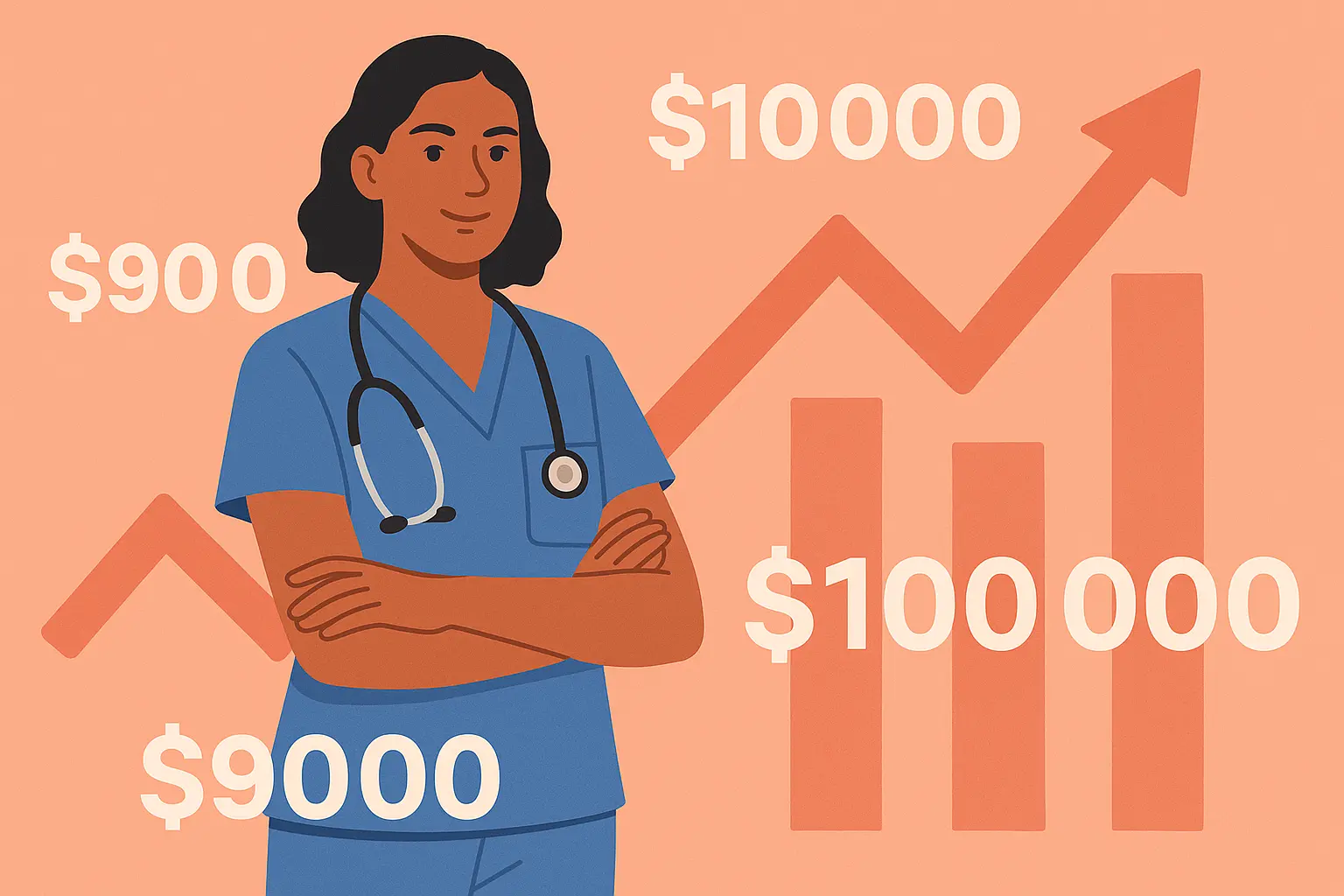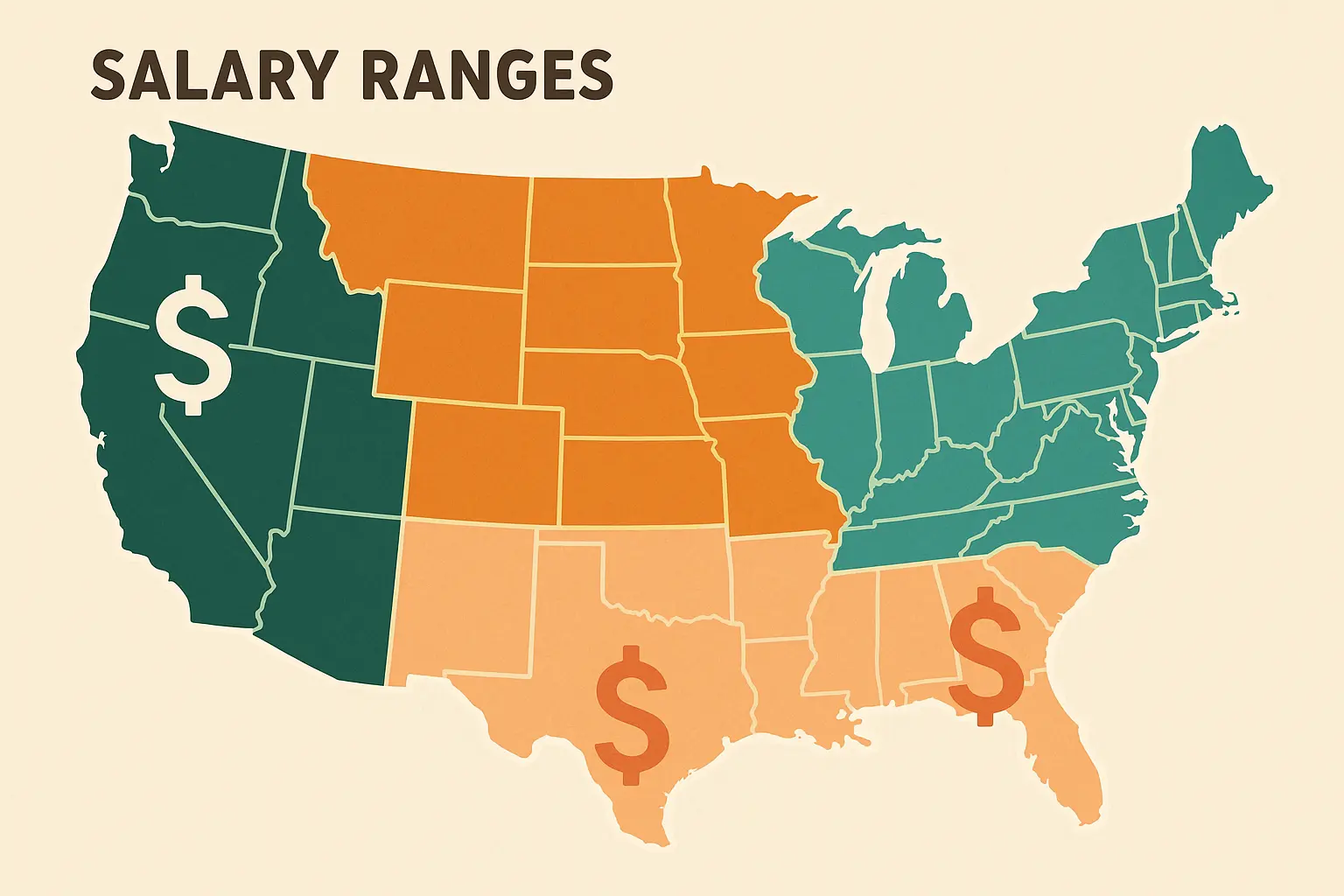FNP Salary Secrets: What Nobody Tells You About Maximizing Your Earning Potential as a Family Nurse Practitioner

Table of Contents
-
Understanding the Real FNP Compensation Picture
-
Geographic Pay Gaps: Where Location Makes or Breaks Your Salary
-
Smart Negotiation Tactics That Actually Work
-
Employment Settings That Pay the Most
-
Building Your Professional Brand for Higher Pay
TL;DR
-
FNP salaries range from $95,000-$125,000 nationally, but smart positioning can push this much higher
-
Acute care NPs earn 10-15% more than family practice roles, with subspecialties adding $5,000-$15,000 annually
-
West Coast and Northeast states offer the highest base salaries, though cost of living matters
-
Rural practices provide loan forgiveness and housing assistance worth $10,000-$25,000 in additional compensation
-
Professional presentation and optimized resumes are crucial for accessing top-paying positions
-
Private practice partnerships and concierge models can increase earnings by 25-40% over traditional employment
Understanding the Real FNP Compensation Picture
Here’s the truth: most FNPs are leaving money on the table. I’ve seen brilliant practitioners stick with $85K jobs while their peers earn $120K+ doing similar work. The difference? They understand what really drives compensation.
Your degree gets you in the door. But your specialty, location, and negotiation skills determine your paycheck.
According to the Bureau of Labor Statistics, the median pay for nurse practitioners in 2022 was $125,900 per year, significantly higher than the $81,220 per year for registered nurses. That’s a massive difference that highlights why advancing your nursing education pays off.
Current Market Realities You Need to Know
We’re living through a healthcare staffing crisis that’s actually working in your favor. The Bureau of Labor Statistics projects that overall employment of nurse anesthetists, nurse midwives, and nurse practitioners is projected to grow 35 percent from 2024 to 2034 – much faster than average.
This isn’t just good news. It’s leverage you can use right now.
Employers are competing for qualified practitioners, and the smart money is on capitalizing on this momentum. That 35% growth projection represents the biggest opportunity FNPs have seen in decades.
What FNPs Are Actually Making Nationwide
Forget those generic salary websites that lump all nurse practitioners together. Real compensation varies wildly. I’ve worked with FNPs making $80,000 in rural areas and others pulling in $160,000+ in major cities.
The median tells you nothing about what you could be earning with the right approach. Similar to how professionals in other healthcare fields are discovering unexpected earning potential, our comprehensive analysis of np salary secrets reveals the strategic approaches that top-earning nurse practitioners use to maximize their compensation packages.
That $95,000-$125,000 range you see everywhere? That’s just the starting point.
Market Forces Working in Your Favor
Three major trends are driving up FNP compensation right now:
Physician shortages in primary care – You’re filling critical gaps that used to require MDs
Healthcare systems expanding access – More clinics, urgent care centers, and telehealth services need providers
Regulatory changes – NPs are getting more autonomy, which means higher compensation
These aren’t temporary blips. They’re structural changes that will keep pushing salaries upward.
According to “Healthcare Careers in Demand” by NCH Stats, nurse practitioners are transforming healthcare as they step in to fill critical gaps left by physician shortages, with advanced qualifications empowering them to diagnose, treat, and manage patient care independently.
|
Market Force |
Impact on FNP Salaries |
Timeline |
|---|---|---|
|
Physician Shortages |
15-25% salary premium in underserved areas |
Immediate |
|
Healthcare Expansion |
New positions, competitive packages |
2-5 years |
|
Regulatory Changes |
Increased autonomy, higher compensation |
Ongoing |
|
Aging Population |
Increased demand for primary care |
Long-term |
How Specialization Changes Everything
Here’s what most FNPs don’t realize: your specialty choice can make or break your earning potential. The difference between general family practice and acute care isn’t just about job duties – it’s about a 10-15% salary premium that compounds over your entire career.
Even within family practice, subspecialties can add thousands to your annual income while making you more marketable.
Acute Care vs. Primary Care: The Pay Gap Reality
Acute care nurse practitioners consistently out-earn their family practice counterparts. Hospital-based care requires split-second decision-making, complex patient management, and higher liability exposure. That 10-15% premium reflects these additional responsibilities.
Take Sarah, an FNP who moved from a family practice clinic ($95,000 annually) to an acute care position at a regional hospital ($110,000 annually). The 16% salary increase came with more pressure, but it also gave her advanced critical care skills that opened doors to even higher-paying positions.
If you’re comfortable with high-acuity patients, this path offers clear financial advantages.
Subspecialty Goldmines Most FNPs Overlook
Adding subspecialty certifications isn’t just professional development – it’s revenue generation. Geriatrics, women’s health, and mental health subspecialties can boost your base salary by $5,000-$15,000 annually.
More importantly, they make you indispensable to employers who need these specialized services.
The growing trend of “dual FNP/PMHNP programs” from Nurse.org highlights how nurse practitioners are pursuing combined specializations, with psychiatric mental health nurse practitioners earning significantly more than traditional FNPs due to high demand for mental health services.
Your Career Progression Roadmap
FNP career advancement follows predictable patterns, but most practitioners don’t plan strategically. The first five years are crucial for establishing your trajectory.
The moves you make early determine whether you plateau at average salaries or continue climbing toward six-figure compensation packages.
From New Grad to Seasoned Professional
New graduate FNPs start at the bottom of salary ranges, but that’s temporary if you play your cards right. According to Medscape’s APRN Compensation Report 2020, FNP annual income increases steadily with experience: 0-5 years earn $109,000, 6-10 years earn $119,000, and 11-20 years command $128,000 annually.
Expect 15-20% increases within your first five years, but only if you’re proactive. Passive practitioners get stuck at entry-level compensation for years.
Michael started as a new graduate FNP at $88,000 in a rural clinic. He strategically pursued diabetes education certification and wound care training. Within three years, he leveraged these subspecialties to secure a position at $105,000, then moved to a hospital-based role earning $118,000 by year five. That’s a 34% increase from his starting salary.
Leadership Roles That Pay
Clinical director positions, administrative roles, and department leadership can boost your salary by 20-30% over direct patient care roles. These positions require different skills than clinical practice, but they offer the highest earning potential for FNPs who want to stay in healthcare.
Certifications That Actually Increase Your Paycheck
Not all certifications impact your salary equally. Diabetes education, wound care, and pain management certifications can add $2,000-$8,000 annually to your base compensation. The key is choosing certifications that align with your employer’s needs.
Certification ROI Checklist:
– Research your employer’s patient population needs
– Calculate certification cost vs. potential salary increase
– Verify continuing education requirements
– Confirm employer recognition and compensation for certification
– Plan timeline for certification completion
– Identify mentors with desired certifications
Geographic Pay Gaps: Where Location Makes or Breaks Your Salary
Geography isn’t just about where you want to live – it’s about maximizing your earning potential. I’ve seen FNPs make $40,000 more by simply crossing state lines, while others discovered that rural positions with loan forgiveness programs beat high-paying urban jobs.
Understanding these dynamics is essential for making smart career decisions.
States That Pay FNPs the Most
Certain states consistently top the FNP salary charts, but the reasons vary dramatically. Some offer high salaries due to cost of living, others because of healthcare infrastructure investments, and still others due to favorable regulatory environments.
Knowing why states pay more helps you evaluate whether the premium is worth the trade-offs.
West Coast and Northeast: Premium Pay, Premium Costs
California, New York, and Massachusetts lead FNP salary rankings with ranges from $120,000-$150,000 annually, but these numbers need context. Housing costs, state taxes, and general living expenses can eat up much of that premium.
However, these states also offer the most subspecialty opportunities and career advancement potential. The infrastructure for professional growth is unmatched.
Hidden Gems: High-Growth Markets with Better Value
Texas, Florida, and Arizona are experiencing healthcare booms that create competitive salary opportunities without crushing cost of living. These markets offer good compensation with reasonable living costs, plus they’re adding healthcare infrastructure rapidly.
|
State Category |
Average FNP Salary |
Cost of Living Index |
Net Value Score |
|---|---|---|---|
|
West Coast (CA, WA, OR) |
$135,000-$150,000 |
130-160 |
Moderate |
|
Northeast (NY, MA, CT) |
$125,000-$145,000 |
120-150 |
Moderate |
|
High-Growth (TX, FL, AZ) |
$105,000-$125,000 |
95-110 |
High |
|
Rural/Incentive States |
$85,000-$105,000 |
85-95 |
High+ |
Urban vs. Rural: More Complex Than You Think
The urban-rural salary debate isn’t simple. While cities typically offer higher base salaries and more opportunities, rural practices often provide incentive packages that make total compensation surprisingly competitive.
Why Urban Markets Still Lead
Metropolitan areas offer higher base salaries, more subspecialty opportunities, and comprehensive benefits packages. Competition is fierce, but career advancement potential and professional networking opportunities often justify higher living costs.
Rural Incentives That Change the Math
Rural practices are getting creative with compensation packages. Loan forgiveness programs, housing assistance, and signing bonuses can effectively add $10,000-$25,000 to your annual compensation.
When you factor in lower living costs, rural positions often provide better financial outcomes than urban jobs.
Jennifer chose a rural FNP position in Montana with a base salary of $92,000, which seemed low compared to urban offers. However, her package included $15,000 in annual loan forgiveness, $8,000 housing allowance, and a $10,000 signing bonus. Combined with 40% lower living costs, her effective compensation exceeded what she would have earned in Denver or Seattle.
Telehealth: Breaking Geographic Barriers
Remote and telehealth positions are revolutionizing FNP compensation by allowing practitioners to access high-paying markets while living in lower-cost areas. This trend creates new opportunities that didn’t exist five years ago.
Smart Negotiation Tactics That Actually Work
Most FNPs approach salary negotiations wrong. They focus solely on base salary, accept the first offer, or worse – they don’t negotiate at all. Successful negotiation requires understanding your market value, timing discussions strategically, and recognizing that total compensation extends far beyond your hourly rate.
The FNPs who master these skills consistently out-earn their peers by significant margins.
Just as mastering negotiation is crucial for FNPs, understanding effective strategies for securing raises can significantly impact your earning trajectory, which is why learning how to ask for a raise strategically becomes essential for advancing healthcare professionals.
Negotiation Fundamentals Every FNP Should Master
Effective salary negotiation starts long before you sit down with a potential employer. It requires comprehensive market research, understanding of employer constraints, and strategic timing.
The FNPs who negotiate successfully treat it as a professional skill worth developing, not an uncomfortable conversation to avoid.
Research That Actually Matters
Generic salary websites won’t cut it for serious negotiation. You need AANP salary surveys, regional healthcare compensation studies, and insider knowledge about specific employers. The more specific your research, the stronger your negotiating position becomes.
Pre-Negotiation Research Checklist:
– Review AANP salary survey data for your specialty
– Research specific employer’s compensation philosophy
– Gather salary data from 3-5 similar positions in your area
– Document your unique qualifications and achievements
– Identify industry salary trends and market conditions
– Prepare questions about total compensation package
– Set your minimum acceptable offer before negotiations begin
Beyond Base Salary: Total Compensation Analysis
Smart FNPs evaluate the entire package: health benefits, retirement contributions, continuing education allowances, malpractice coverage, and paid time off. Sometimes a lower base salary with excellent benefits beats a higher salary with minimal perks.
Understanding these trade-offs helps you negotiate more effectively. This becomes even more crucial when you consider tools like our comprehensive salary increase calculator secrets guide, which helps healthcare professionals quantify the true value of benefits packages and negotiate more effectively.
Professional Development as Salary Strategy
Continuous professional development isn’t just about staying current – it’s about creating leverage for salary increases. Employers reward advanced skills and certifications with higher compensation, but only if you’re smart about which investments you make and how you present their value.
Continuing Education ROI
Well-chosen continuing education investments can yield 3-5% annual salary increases, particularly in high-demand areas like mental health or geriatrics. The key is choosing education that directly addresses your employer’s needs and patient population challenges.
Professional Networks That Open Doors
Active participation in organizations like AANP or state NP associations provides access to job opportunities, salary benchmarking data, and career advancement resources that aren’t available elsewhere. These connections often lead to opportunities that never get posted publicly.
Employment Settings That Pay the Most
Where you work matters as much as what you do when it comes to FNP compensation. Hospital systems, private practices, and emerging care models each offer distinct salary structures, benefits packages, and growth opportunities.
Understanding these differences helps you choose settings that align with both your financial goals and professional preferences.
Hospital Systems and Health Networks
Large hospital systems typically offer the most comprehensive compensation packages with structured salary scales and clear advancement pathways. While they may have less flexibility in base salary negotiation, their benefits packages and job security often make up for it.
These environments also provide the most opportunities for subspecialty development and career advancement. The resources available for professional growth are unmatched in most other settings.
Academic Medical Centers: Beyond the Paycheck
Teaching hospitals offer competitive salaries plus unique opportunities for research, publishing, and precepting students that can enhance your long-term career prospects. These additional responsibilities often come with stipends or salary premiums, and they make you more marketable for future positions.
The intellectual stimulation and professional prestige of academic medicine can be worth thousands in intangible benefits.
Community Hospitals: Hidden Benefits
Community hospitals frequently offer signing bonuses, relocation assistance, and flexible scheduling arrangements that add significant value beyond base salary. They also tend to have less bureaucracy than large health systems, allowing for more personalized career development.
Healthcare professionals transitioning between different employment settings often benefit from understanding how compensation structures vary across industries, similar to insights found in our analysis of physician assistant salary secrets which reveals comparable strategic approaches to maximizing healthcare career earnings.
Private Practice: Risk and Reward
Private practice settings offer the most diverse compensation models, from traditional employee positions to partnership opportunities that can dramatically increase earning potential. However, they also require more business acumen and often involve greater financial risk.
Employee vs. Partnership: Different Games Entirely
Employee positions in private practice typically offer steady salaries with benefits, while partnership tracks can lead to significantly higher earnings but require business investment and risk tolerance. Understanding these models helps you choose the path that matches your financial goals and risk appetite.
Partnership opportunities can increase your earning potential by 40-60% over employee positions, but they come with business responsibilities that many FNPs aren’t prepared for.
Concierge and Direct-Pay Models: Premium Opportunities
Emerging practice models allow FNPs to command premium fees for personalized care, potentially earning 25-40% more than traditional practice settings. These models require different skills but offer the highest earning potential for FNPs willing to embrace entrepreneurial approaches.
The patient relationships in these settings are deeper and more rewarding, which many practitioners find professionally fulfilling beyond the financial benefits.
Building Your Professional Brand for Higher Pay
Your ability to secure top-tier FNP positions depends heavily on how you present your qualifications to potential employers. In today’s competitive healthcare job market, having a professionally crafted, ATS-optimized resume isn’t optional – it’s essential for reaching the interview stage where salary negotiations happen.
Resume Builder IQ addresses this critical need by providing FNP professionals with AI-powered resume creation tools specifically designed for healthcare careers, helping you translate your clinical experience into achievement-focused descriptions that demonstrate your value to potential employers.
Creating a compelling professional presentation starts with understanding the technical requirements of modern hiring systems, which is why mastering ATS-friendly resume secrets becomes crucial for FNPs seeking to access the highest-paying positions in competitive healthcare markets.
Professional Brand Building Template:
– Create ATS-optimized resume highlighting quantifiable achievements
– Develop LinkedIn profile with industry keywords and recommendations
– Document patient outcomes and quality improvement initiatives
– Collect letters of recommendation from supervisors and colleagues
– Build portfolio of continuing education certificates and achievements
– Establish thought leadership through professional writing or speaking
– Maintain active membership in professional organizations
Beyond technical resume optimization, healthcare professionals must also understand strategic career positioning, which our guide on top nursing resumes demonstrates through real-world examples of how successful nurses and nurse practitioners present their clinical achievements to maximize earning potential.
Final Thoughts
Maximizing your FNP salary isn’t about luck or hoping someone recognizes your worth – it’s about smart career planning, understanding market dynamics, and positioning yourself for success. The healthcare industry desperately needs qualified FNPs, and that demand translates into leverage you can use to build a financially rewarding career.
Remember that salary is just one component of total compensation. Benefits, professional development opportunities, work-life balance, and career advancement potential all contribute to your overall job satisfaction and long-term financial success. The highest-paying position isn’t always the best choice if it doesn’t align with your personal and professional goals.
Take action on what you’ve learned here. Research salary ranges in your target markets, identify subspecialty opportunities that interest you, and start building the professional relationships that will open doors to better opportunities. Your FNP career has tremendous earning potential – but only if you approach it strategically and advocate for yourself effectively.









